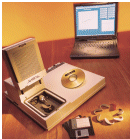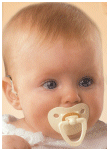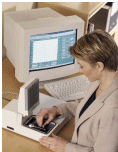Audiological Assessment Products
ICS Medical - A GN Otometrics Company
INTRODUCTION:
Audiologists are aware that when testing children, traditional adult techniques do not necessarily provide accurate results. Audiometric thresholds may need to be estimated from electroacoustical procedures such as tone burst ABR (auditory brainstem response) and ASSR (auditory steady state response) and arguably, typical 226 Hz tympanometry may not be valid across the pediatric population. Frequent re-testing is required, especially during the first years.
It's no surprise, that during the fitting process, smaller volume infant ear canals can alter the gain of the prescribed electroacoustic characteristics of the hearing aid. This needs to be carefully anticipated and managed in the fitting process. Real-ear measures of hearing aid gain and output are more accurate and reliable than functional gain measures.
Additionally, real-ear measures can provide an estimate of the maximum sound pressure level (SPL) delivered to the ear with the hearing aid in the ear canal. This is an important consideration when fitting hearing aids for infants and young children. Infant ear canal SPL values could be 20 dB higher than measured gain output from a 2 cc coupler. These are differences we must identify, quantify and account for during the hearing aid fitting process.
Real ear measurement (REM) equipment provides simple test protocols for assessing real ear measures in infants, children, and adults. Real-ear measures are reliable, can be obtained quickly, and provide frequency and intensity information. Unlike functional gain, these measures provide information about gain for speech-level inputs and maximum sound pressure levels delivered to the ear. 
It is difficult to complete traditional real-ear probe-microphone measures on infants because of their random movements and lack of head control.
FITTING PROCESS:
For a variety of reasons, real-ear measures are the preferred method to document hearing instrument performance. A proven alternative to traditional probe-microphone measures is to obtain real-ear to coupler differences (RECD). The RECD, measured with the infant's own ear mold can be used in combination with test-box measures to predict real-ear responses.
Prescriptive approaches are used to fit hearing aids for babies. Desired Sensation Level (DSL) is a common method used for pediatric fittings.
When an audiologist selects hearing aids for infants, Real Ear Unaided Responses (REUR) are the necessary starting point. Many studies have demonstrated (Krueger and Reuben 1987) variable resonant peaks for infant ears (possibly 7200 Hz) as compared to adult ears (typically 2700 Hz). This is mostly due to the smaller ear canal diameter and the shorter canal length in infant ears. 
Resonant responses of the ear change with age and require regular evaluation of real ear values in infants and small children. These values are important for hearing aid selection. For example, the infant ear will have a Real Ear Insertion Response (REIR) around 3000 Hz, which gradually decreases as the infant grows. If a peak in the 3000 Hz range is not adequate, the ear mold insertion will cause an elevated REIR in this frequency range. When fitting infants with hearing aids, we need to keep in mind that more gain may be initially needed in the 3000 Hz range, and less gain is needed (at 3000 Hz) as the child grows and approaches the age of 2. Therefore, when using REIR to fit infants with hearing aids, the electroacoustic characteristics of the hearing aid will need to change as the child grows.
OBTAINING REAL EAR MEASUREMENTS IN INFANTS:
The following steps are necessary to collect real ear data in infants:
- Tone burst or other frequency specific thresholds measurements should be obtained prior to the hearing aid fitting. These thresholds can be applied to prescriptive methods such as Desired Sensation Level (DSL) to determine the proper gain and maximum output required for the hearing aid fitting. The DSL method provides targets for gain and output, and compression ratios. Other prescriptive procedures are available. Most manufacturers provide proprietary algorithms or other prescriptive methods with their advanced technology devices. Frequency specific ABR thresholds can easily be entered into the DSL program to generate target values for probe tube measurements and coupler values. These values can be used as "starting points" to select and program hearing aids. Additional probe microphone measurements can be used to confirm the fit.
- The stimulus is presented into a standard 2-cc coupler via an insert earphone and the SPL is measured; this is the coupler response.
- A probe microphone is placed in the child's ear canal and the same insert phone (which has been coupled to the child's ear mold) is used to deliver the signal to the ear. The difference between the real-ear and coupler response is the Real Ear to Coupler Difference (RECD). This value is added to the hearing aid response measured in the coupler to predict the real-ear response. According to Stelmachowicz and Seewald (1991), the probe tube should be inserted 10 mm past the ear canal entrance.
This procedure can be completed in both ears in approximately 5-10 minutes. All subsequent measures can be made in the test box. The attached tutorial provides a step-by-step description of this procedure. For additional information, a suggested readings and reference list is offered at the end of this article.
HEARING AID CONSIDERATIONS:
Selected hearing aids should be digital, or digitally programmable, allowing tremendous flexibility regarding gain, maximum output, and frequency response, and the changes likely to be needed over time. Continuous monitoring and testing should be performed on the child until consistent and reliable sound field thresholds can be determined. The audiologist should determine the best "follow-up" schedule based on the individual's needs of the child/patient.

Hearing aid selection for most children should consider the following:
- Direct audio input. FM systems should be considered when the child becomes older and more mobile and needs to listen from greater distances. FM technology is the system of choice to improve signal-to-noise ratio and most hearing aid companies offer pediatric hearing aid solutions, which include an FM compatible boot.
- Directional microphones should be considered for older children to improve signal-noise-ratio when FM technology is not being used. Very young children need to hear environmental noise and distance speech from all directions to maximize language and speech development; therefore, directional microphones are not usually recommended for this population.
- Tele-coil (T) for telephone usage and a microphone-telecoil (M-T) switching option, and direct audio input (DAI).
- Safety features-tamper resistant battery compartment and volume control covers.
- Flexibility in setting the electroacoustic parameters of the hearing aid is essential. Advanced technology (digital and digitally programmable) hearing aids and the use of multiple channels should be considered when the audiometric configuration requires gain or output modifications in specific frequency regions.
- The physical fit of the hearing aids and ear molds is important for both comfort and retention. Ear molds should be made of a soft material for safety and comfort. They should be replaced at least 3 or 4 times a year and whenever feedback is excessive at optimal settings or the fit becomes loose or comfort issues occur. Retention devices and options: "Huggies", toupee tape, cords, "Critter Clips," headbands.
- Behind-the-ear hearing aids are the style of choice for most children. In-the-ear hearing aids are not generally recommended for infants and young children due to their small ear canal sizes and rapid growth of the outer ear.
- Binaural amplification should always be provided to young children with binaural hearing loss unless there is a medical contraindication.
- A bone conduction hearing aid may be appropriate if the loss is conductive and BTE's cannot be used due to medical or physical contraindications.
- Cochlear implants may be considered if the child has a profound sensorineural hearing loss bilaterally, has used appropriate hearing aids consistently for 6 months, has been enrolled in an early intervention program, exhibits minimal or no benefit from hearing aids, and meets medical candidacy and age requirements
The golden rule: The child's own speech and that of others should be audible, comfortable, and clear. Validation for pediatric hearing aid fittings is of course challenging. However, there are available tools to help confirm appropriate hearing aid fittings. See "Suggested Readings and References" below.
FOLLOW-UP
Periodic audiologic re-evaluation is essential: For example, a re-check 1 month following initial fitting, and perhaps rechecks at 2-3 month intervals for the first year of amplification; every 4-6 months until age 5 and annually thereafter.
The frequency of follow-up may need to be increased if fluctuation/progression of the hearing loss is noted and/or if progress is not as might be expected. Ongoing communication between the clinical audiologist and the members of the early team is critical.
Suggested Readings and References:
Beauchaine, K.L., Launer, S., Kühnel, V., Scollie S.D., & Seewald R.C. : Pediatric Hearing Instrument Fitting. Audiology Online archived article, PDF, Adobe required. /audiology/newroot/articles/arc_disp.asp?id=406&catid=1&type=pdf
Gorga. M. P., Neely, S.T., Picton, T.W., et al. Assessment Strategies for Hearing Instrument Fittings. Audiology Online archived article, PDF, Adobe required. /audiology/newroot/articles/arc_disp.asp?id=399&catid=1&type=pdf
Gross, A., (2003) Fitting Techniques for the Pediatric Cochlear Implant Patient.
Audiology Online article archives. /audiology/newroot/articles/arc_disp.asp?article_id=424&catid=9
Krueger, B. & Reuben (1987). The acoustic properties of the infant ear. Acta Otolaryngologica, 103 578-585.
Pumford, J., & Sinclair, S.: Real-Ear Measurement: Basic Terminology and Procedures. Audiology Online archived article. /audiology/newroot/articles/arc_disp.asp?id=285&catid=1
Sininger, Y.S.: Otoacoustic Emissions in the Diagnosis of Hearing Disorder in Infants. This article was previously published in The Hearing Journal. Audiology Online archived article, PDF, Adobe required. /audiology/newroot/articles/arc_disp.asp?id=414&catid=4&type=pdf
Stapells. D.R., This article was previously published in The Hearing Journal. Audiology Online archived article, PDF, Adobe required. The Tone-Evoked ABR: Why It's the Measure of Choice for Young Infants. /audiology/newroot/articles/arc_disp.asp?id=413&catid=4&type=pdf
Stelmachowicz, P.G., Hoover, B., Lewis, D.E., & Brennan, M.: Is Functional Gain Really Functional. This article was previously published in The Hearing Journal. Audiology Online archived article, PDF, Adobe required. /audiology/newroot/articles/arc_disp.asp?id=419&catid=1&type=pdf
Stelmachowicz and Seewald (1991). Probe-tube mircrophone measures in children. Seminars in Hearing, 12 62-72.
Universal Newborn Hearing Screening (UNHS) /Early Hearing Detection and Intervention (EHDI) Program - recommended protocol for pediatric amplification. https://www.health.state.mn.us/divs/fh/mch/unhs/resources/amplification.html
For more information on ICS Medical click here.
Click here to visit the ICS Medical website.
